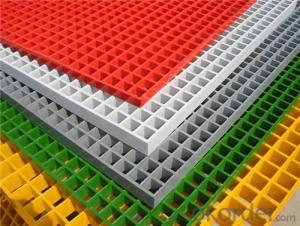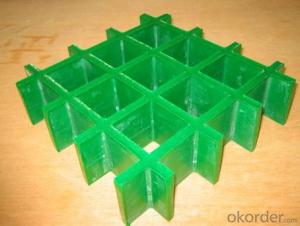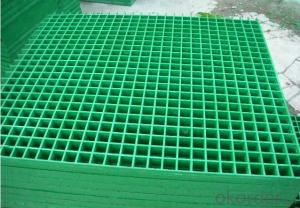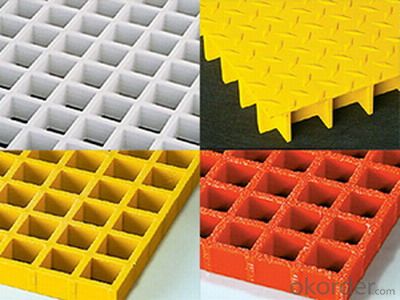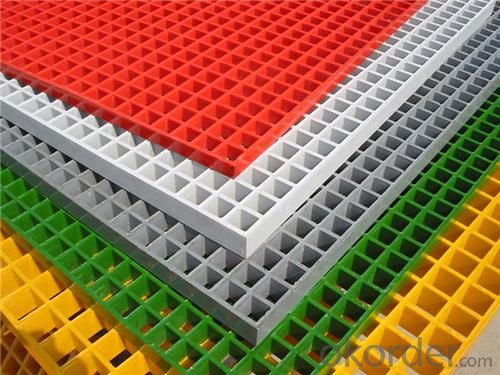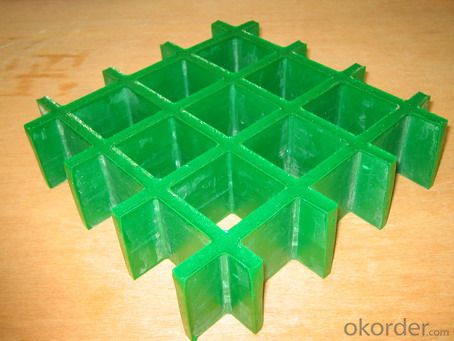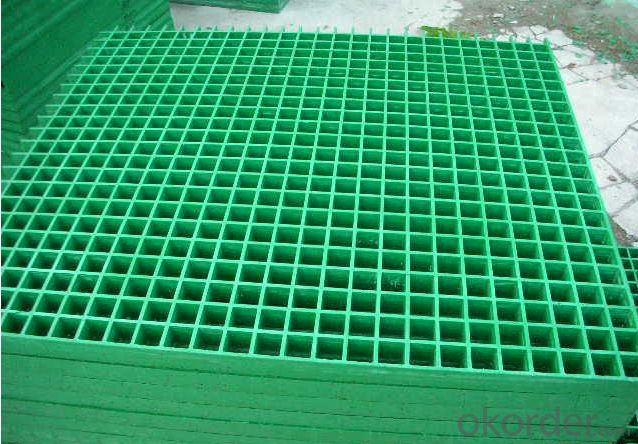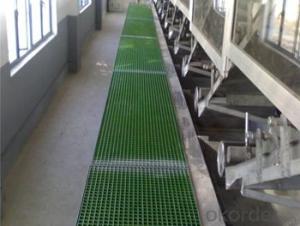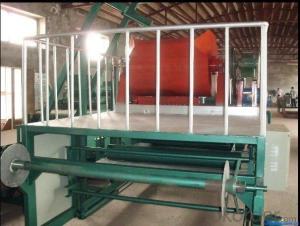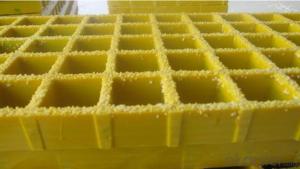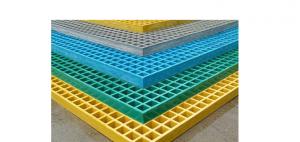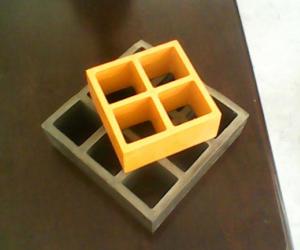FRP Pultrusion Profiles Molded Gratings
- Loading Port:
- Shanghai
- Payment Terms:
- TT or LC
- Min Order Qty:
- 10 m
- Supply Capability:
- 50000 m/month
OKorder Service Pledge
OKorder Financial Service
You Might Also Like
Brief Introduction of FRP Molded Gratings
The product is a kind of structural plates which uses high-strength fiberglass roving as reinforcing material, thermosetting resin as the base and then is cast and formed on a special metal mold. It provides properties such as: light in weight, high in strength, corrosion resistance, fire resistance, solid and anti-skid. It is widely used in oil industry, power enrineering, sewage treatment, ocean survey as working floor, stair tread, trench cover, and the . It is an ideal loading frame on corrosion circumstances.
Product Performance of FRP Molded Gratings
1. Corrosion-resistance
2. Fire-resistance
3. Light in weight and high in strength
4. Ageing resistance
5. Designable
6. Safe and anti-skid
7. Insulation
Main Application of FRP Molded Gratings
Operation terrace off-shore oil rig Inspection rack
Stair tread Ground floor
Trench cover
Bridge sidewalk foot bridge
Equipment safety fence
Stair landing
Scaffold filling supporting
Decorating grid
Air grid, etc.
Specification of FRP Molded Gratings
Type | Panel size mm | Lattice size mm | Void ratio | Panel weight Kg |
AS/38.1 x38.1/25.4 | 1220 x 3660 x 25.4 | 38.1*38.1 | 69.9 | 64 |
AS/25.4 x101.6/25.4 | 1220 x 3660 x 25.4 | 25.4 x 101.6 | 63.9 | 73 |
AS/38.1 x38.1/38.1 | 1220 x 3660 x 38.1 | 38.1*38.1 | 70.0 | 92 |
AL/38.1 x38.1/38.1 | 1520 x 3960 x 38.1 | 38.1*38.1 | 70.0 | 114 |
AS/50.8 x50.8/50.8 | 1220 x 3660 x 50.8 | 50.8 x 50.8 | 77.8 | 101 |
AS/38.1 x152.4/38.1 | 1220 x 3660 x 38.1 | 38.1*152.4 | 72.6 | 87 |
AS/38.1 x152.4/38.1 | 579 x 3048 x 38.1 | 38.1 x 152.4 | 74.8 | 34 |
JS/340x40/25 | 1247 x 3087 x 25 | 40 x 40 | 72.3 | 46 |
JS/40 x40/40 | 1247 x 3087 x 40 | 40 x 40 | 72.3 | 73 |
ES/52 x52 /30 | 1000 x 4000 x 30 | 52 x 52 + 19 x 19 | 70.0 | 72 |
ES/52 x52 /50 | 1000 x 4000 x 50 | 52 x 52 + 19 x 19 | 73.3 | 108 |
GS/100 x 100 /25.4 | 117.5 x1480 x25.4 | 100 x 100 | 83.8 | 9 |
FAQ:
1. Why Choose us?
CNBM is a stated owned company, provide the guarantee for the best quality, best service and safety business.
2. How will we guarantee the quality?
a, ISO 9001-2008 quality control system;
b, Strict and regular quality control in production;
c, Inspeciation when loading into container before shippment;
3. Can you provide sample?
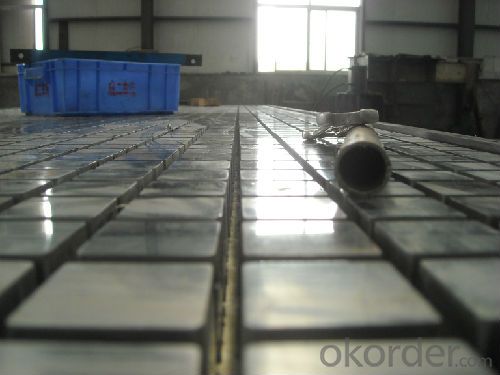
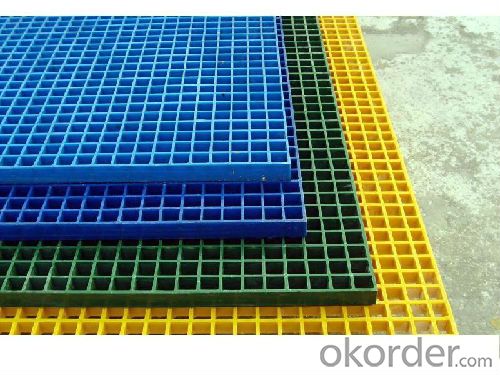
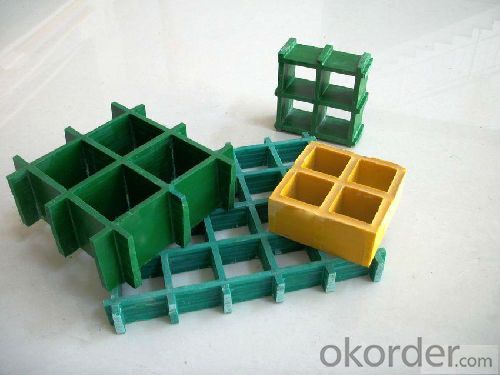
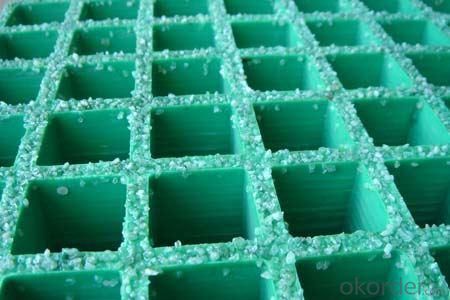
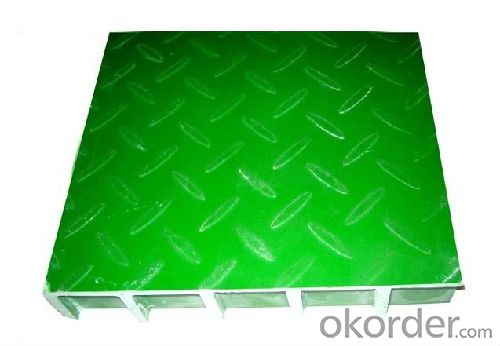
- Q: How do FRP pultrusion profiles perform in extreme humidity conditions?
- FRP pultrusion profiles perform exceptionally well in extreme humidity conditions. The fiberglass-reinforced plastic material used in the profiles is highly resistant to moisture absorption, preventing any degradation or dimensional changes. This makes them ideal for applications in humid environments, as they maintain their strength, durability, and structural integrity over time.
- Q: How do FRP pultrusion profiles perform in high-vibration applications?
- High-vibration applications are where FRP (Fiber Reinforced Polymer) pultrusion profiles truly excel. The exceptional properties of FRP materials make them an ideal choice for these situations. To begin with, FRP pultrusion profiles are renowned for their impressive strength-to-weight ratio. Unlike traditional materials like steel or aluminum, FRP profiles are significantly lighter while still possessing remarkable strength and rigidity. This lightweight quality reduces the overall mass of the structure, resulting in lower vibration amplitudes. Furthermore, FRP materials boast outstanding damping characteristics. Damping refers to a material's ability to dissipate energy and decrease vibration amplitudes. In comparison to other materials, FRP pultrusion profiles have a higher damping coefficient, meaning they can more effectively absorb and dissipate vibrations. This minimizes the transmission of vibrations throughout the structure, reducing the risk of resonance and fatigue failure. In addition, FRP pultrusion profiles demonstrate exceptional resistance to fatigue and corrosion. Vibrations can cause cyclic loading, which can lead to fatigue failure over time. However, the inherent properties of FRP materials, including their excellent tensile strength and resistance to environmental factors, make them highly resilient to fatigue and corrosion. This guarantees the longevity and durability of the profiles, even in high-vibration environments. Moreover, FRP pultrusion profiles offer immense design flexibility, allowing for customized shapes and sizes that can be tailored to specific applications. This flexibility allows engineers to optimize the profiles' performance in high-vibration scenarios by adjusting the geometry and composition to enhance their dynamic characteristics. In summary, FRP pultrusion profiles are exceptionally suited for high-vibration applications due to their lightweight nature, excellent damping characteristics, resistance to fatigue and corrosion, and design flexibility. These profiles provide a reliable and durable solution that can effectively withstand the challenges posed by vibrations, ensuring safe and efficient operation in such environments.
- Q: Can FRP pultrusion profiles be used in renewable energy projects?
- Yes, FRP pultrusion profiles can be used in renewable energy projects. FRP (Fiber Reinforced Polymer) pultrusion profiles offer high strength, durability, and corrosion resistance, making them suitable for various applications in renewable energy projects. They can be used in the construction of wind turbine blades, solar panel frames, and structural supports for renewable energy infrastructure. Additionally, FRP pultrusion profiles can provide cost-effective solutions by reducing maintenance requirements and improving the overall performance of renewable energy systems.
- Q: Can FRP pultrusion profiles be used in agricultural structures?
- Agricultural structures can indeed utilize FRP pultrusion profiles. FRP pultrusion profiles, also known as Fiber Reinforced Polymer profiles, possess numerous advantages that render them suitable for agricultural purposes. To begin with, the corrosion resistance of FRP profiles is of utmost importance in the agricultural industry, given the exposure of structures to harsh environments and chemicals like fertilizers and pesticides. Unlike conventional materials such as steel or wood, FRP does not rust or decay, ensuring enduring performance in agricultural structures. Furthermore, FRP profiles are lightweight yet durable, facilitating easy handling and installation in agricultural applications. Their high strength-to-weight ratios enable efficient construction, thereby reducing the necessity for heavy machinery during the installation process. Moreover, FRP profiles exhibit exceptional mechanical properties, including high stiffness and impact resistance, which prove advantageous for agricultural structures subjected to heavy loads, vibrations, or machinery impact. In addition, FRP pultrusion profiles can be designed to resist UV radiation, thereby preventing degradation from prolonged exposure to sunlight. This quality makes them suitable for outdoor agricultural structures consistently exposed to the elements. Lastly, FRP profiles are non-conductive, a critical advantage in agricultural environments where electrical safety is paramount. This characteristic eliminates the risk of electrical hazards associated with conductive materials like steel. In summary, FRP pultrusion profiles offer a reliable and efficient solution for a variety of agricultural structures, such as greenhouse frames, livestock enclosures, irrigation systems, and storage facilities. Their corrosion resistance, lightweight nature, high strength, UV resistance, and non-conductivity make them an ideal choice for agricultural applications.
- Q: Are FRP pultrusion profiles resistant to high-pressure gas?
- Yes, FRP (Fiber Reinforced Polymer) pultrusion profiles are generally resistant to high-pressure gas. FRP materials have excellent chemical resistance and are often used in applications where they come into contact with various chemicals, including gases under high pressure. The specific resistance of FRP pultrusion profiles to high-pressure gas will depend on the specific resin and reinforcement used in their construction. It is important to consult the manufacturer's specifications and guidelines to ensure that the specific FRP profiles being used are suitable for the intended high-pressure gas application.
- Q: Can FRP pultrusion profiles be used in the construction of water treatment plants?
- Yes, FRP (Fiber Reinforced Polymer) pultrusion profiles can be used in the construction of water treatment plants. FRP pultrusion profiles offer several advantages such as high strength-to-weight ratio, corrosion resistance, and durability, making them well-suited for water treatment plant applications. These profiles can be used in various structural components like beams, columns, grating, and handrails, providing a cost-effective and long-lasting solution for the construction of water treatment plants.
- Q: What are the quality control measures for FRP pultrusion profiles?
- To ensure the desired standards are met, a series of steps and processes are involved in quality control measures for FRP pultrusion profiles. These measures encompass: 1. Inspection of raw materials: The initial step involves verifying the quality of the raw materials used in the pultrusion process. This entails assessing the properties and specifications of components such as fiberglass, resin, additives, and others. 2. Control of the process: Throughout the pultrusion process, it is crucial to monitor and control various parameters. This includes maintaining consistent temperature, pressure, and resin content during impregnation, forming, and curing stages. 3. Testing of samples: Regular sampling is conducted during production to evaluate profile quality. Mechanical properties, dimensional accuracy, and surface finish are tested to ensure they align with the required standards. 4. Visual examination: Each profile undergoes visual inspection to identify any defects, such as cracks, voids, delamination, or surface imperfections. This examination aids in detecting irregularities that may impact the profiles' structural integrity or aesthetics. 5. Mechanical assessment: Profiles are subjected to mechanical testing to evaluate strength, stiffness, and other mechanical properties. Flexural, tensile, impact, and compression tests are conducted, comparing the results to specified requirements to determine compliance with necessary standards. 6. Documentation of quality: Proper documentation is maintained throughout the manufacturing process, encompassing records of raw material specifications, process parameters, test results, and inspection reports. This ensures traceability and serves as a reference for quality assurance. 7. Non-destructive testing: In addition to mechanical testing, non-destructive techniques like ultrasonic testing or X-ray inspection may be employed to identify internal defects or inconsistencies without causing damage to the profiles. 8. Quality audits: Regular internal and external audits are performed to evaluate the effectiveness of quality control measures and ensure adherence to relevant industry standards and regulations. By incorporating these quality control measures, manufacturers can guarantee that FRP pultrusion profiles meet the necessary specifications, resulting in dependable and high-quality products.
- Q: Are FRP pultrusion profiles resistant to hydrochloric acid?
- Yes, FRP pultrusion profiles are generally resistant to hydrochloric acid due to the corrosion-resistant properties of the fiberglass reinforcement and the resin matrix used in their construction. However, the specific resistance may vary depending on the composition and concentration of the acid, and it is recommended to consult the manufacturer's specifications for detailed information regarding chemical resistance.
- Q: Can FRP pultrusion profiles be used in the construction of outdoor signage?
- Certainly, outdoor signage can utilize FRP pultrusion profiles. These profiles possess remarkable qualities, including durability, strength, and the ability to withstand different environmental conditions, rendering them ideal for outdoor use. Typically, these profiles consist of a combination of fiberglass reinforcement and resin matrix, resulting in a lightweight yet robust material. Outdoor signage often confronts harsh weather conditions, such as rain, sun exposure, and temperature fluctuations. FRP pultrusion profiles exhibit excellent resistance to corrosion, UV rays, and moisture, ensuring that the signage retains its structural integrity and visual appeal over time. Moreover, FRP pultrusion profiles offer customization options to fulfill specific design requirements, offering flexibility in creating distinctive and captivating outdoor signage. These profiles can be effortlessly shaped, cut, and assembled, making them a versatile choice for signage applications. In essence, the construction of outdoor signage can undoubtedly benefit from the use of FRP pultrusion profiles due to their durability, resistance to environmental conditions, and design flexibility.
- Q: Can FRP pultrusion profiles be used in the construction of stadium seating?
- Yes, FRP (Fiber Reinforced Polymer) pultrusion profiles can be used in the construction of stadium seating. FRP pultrusion profiles have several advantages that make them suitable for this application. Firstly, FRP pultrusion profiles are lightweight yet strong, which is ideal for stadium seating where a large number of seats need to be installed. The lightweight nature of FRP profiles makes them easier to handle and install, reducing the time and effort required for construction. Secondly, FRP pultrusion profiles are highly durable and resistant to corrosion, making them suitable for outdoor applications like stadium seating. They are not prone to rusting, rotting, or degradation from exposure to moisture, UV rays, or chemicals commonly found in stadiums. Additionally, FRP pultrusion profiles are non-conductive, providing an added safety benefit, especially in areas where electrical wiring may be present. This reduces the risk of electric shocks or accidents that can occur with conductive materials. Furthermore, FRP pultrusion profiles can be customized to meet specific design requirements, allowing for flexibility in designing stadium seating layouts. They can be manufactured in various shapes, sizes, and colors to match the aesthetic and functional requirements of the stadium. Lastly, FRP pultrusion profiles have a long service life with low maintenance requirements, reducing the overall cost of ownership for stadium seating. This makes them a cost-effective choice in the long run. In conclusion, FRP pultrusion profiles are an excellent choice for the construction of stadium seating due to their lightweight, durable, non-conductive, customizable, and cost-effective nature.
Send your message to us
FRP Pultrusion Profiles Molded Gratings
- Loading Port:
- Shanghai
- Payment Terms:
- TT or LC
- Min Order Qty:
- 10 m
- Supply Capability:
- 50000 m/month
OKorder Service Pledge
OKorder Financial Service
Similar products
Hot products
Hot Searches
Related keywords

